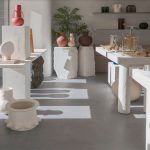Grass House: healthy alternative to stick-frame construction
The Grass House is a LEED Platinum accessory structure built behind a recently renovated 1892 Victorian house in the Historic Anacostia neighbourhood of Washington, D.C.
Utilizing natural, traditional building materials processed with simple but modern techniques, the Grass House proposes a contextual and healthy alternative to standard stick-frame construction.

GALLERY
The Grass House is the first code-compliant bamboo building on the East Coast and a morsel of promise in the quest for affordable, high-quality, and healthy building materials. Changes to the city zoning code enabled the construction of this backyard studio space, providing workspace for B L D U S, freeing up space in the historic house that had previously functioned as home-office space, and shortening daily commutes.
The Grass House calls into question the fundamentals of the built environment while retaining roots in traditional aesthetics and craftsmanship. Designed as much for the hand to touch and the nose to smell as for the eye to see, the Grass House asks its inhabitants to reconsider their relationship to air, water, sunlight, and the ground.
Nestled across the street from the Frederick Douglass House, in a neighbourhood frequented by tourists but plagued by violence, the Grass House is a testament to the rights of all to healthy habitation. The Grass House was built in the midst of a community that is learning about architecture and development in order to advocate for a better future for themselves and their neighbourhood.
In that sense, the Grass House is a diagram of the possible, built as a way to learn about the potential of healthy systems alongside the building’s inquisitive neighbours. Surrounding Anacostia are large-scale public housing projects with histories of mould growth, pest infestation, and toxic chemical exposure; the Grass House suggests a new way forward.
The Grass House is an exploration into the economies of clean, healthy building materials. Proof-of-concept for BamCore’s framing system, Omniblock’s insulated masonry units, and sheep’s wool insulation, and showcasing beautiful local materials through finely crafted details, the Grass House lurks in the shadows of the nation’s Capital.
This farm-to-shelter architecture invites people to understand where a building’s materials originate, how they arrive at the site, how they are processed, and how they will be disposed of when the building is eventually dismantled. The Grass House is intended to question what “clean” and “healthy” can mean in architecture today and in the future—for humans, for other species, and for the Earth.
Images by Ty Cole via ArchDaily
Nestled along the pristine shores of Cronulla, NSW, the latest luxury duplex development, ‘Azurea’ at Elouera Road embodies ...
The completion of Parkline Place marks a major milestone for Sydney’s skyline, with the 39-storey commercial tower now ...
Milan-based interior design practice Studio Shoo has completed an innovative retail space in Yerevan, Armenia, seamlessly blending sculptural ...











